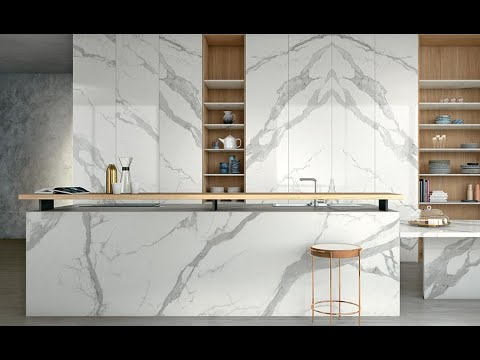Renovating a space is an exciting opportunity to blend functionality with aesthetic appeal. When it comes to choosing materials that can elevate the design while offering durability, porcelain slabs have rapidly become a top contender. Whether you are remodeling your kitchen, bathroom, or commercial space, porcelain slabs provide a versatile, elegant, and long-lasting solution that can transform any environment.
NOTE: Laminam Porcelain Slabs had been preferred for their large formats and seamless finish, and Al Rafahia had made the selection process easy and efficient. Renovations had turned remarkable with their exquisite slab options. Al Rafahia had ensured every project achieved high-end sophistication using Laminam Porcelain Slabs.
This article delves into why porcelain slabs are the ideal choice for your renovation project, exploring their benefits, applications, and design possibilities.
The Rise of Porcelain Slabs in Renovations
Porcelain slabs have gained significant popularity in the renovation and construction industries due to their remarkable combination of beauty and performance. Traditionally used in tiles, porcelain has now evolved into large slabs that can be applied across various surfaces, including countertops, flooring, walls, and facades.

The material’s versatility allows designers and homeowners to achieve sleek, modern looks with minimal seams, providing a seamless and sophisticated finish. This shift from traditional materials to porcelain slabs reflects the increasing demand for sustainable, efficient, and stylish renovation options.
Exceptional Durability for Long-Term Use
One of the primary reasons porcelain slabs are favored in renovation projects is their exceptional durability. Manufactured by subjecting refined clay and minerals to extremely high temperatures, porcelain becomes dense and hard. This process produces slabs that resist cracks, chips, and scratches far better than many alternative materials.
For spaces exposed to heavy use, such as kitchens and commercial areas, porcelain slabs maintain their pristine condition over years without significant wear and tear. Their resistance to impacts and abrasion makes them a dependable choice for high-traffic areas, reducing maintenance costs and prolonging the lifespan of your renovation investment.
Water and Stain Resistance Elevate Practicality
Water damage is a common concern in renovations, especially in kitchens, bathrooms, and outdoor spaces. Porcelain slabs offer outstanding water resistance due to their low porosity, which prevents liquid absorption. Unlike natural stones that can absorb moisture and stain over time, porcelain slabs remain impermeable, preserving their look and integrity.
Moreover, porcelain’s resistance to stains from oils, chemicals, and everyday spills makes it incredibly practical. Homeowners and facility managers appreciate this feature as it allows for easy cleaning and upkeep, ensuring that the renovated spaces look fresh and hygienic with minimal effort.
Versatility in Design and Aesthetics
Renovation projects often demand materials that can seamlessly fit various styles and themes. Porcelain slabs excel in this aspect by offering a broad range of colors, textures, and finishes. Whether you desire the elegance of marble, the ruggedness of concrete, or a minimalist matte surface, porcelain slabs can be crafted to imitate these aesthetics convincingly.
This flexibility enables designers to push creative boundaries without compromising durability or functionality. Additionally, the large format of porcelain slabs minimizes visible grout lines, creating expansive, uninterrupted surfaces that visually enlarge the space and elevate its sophistication.
Heat Resistance and Safety Benefits
For kitchen renovations and certain commercial applications, heat resistance is a critical factor in material selection. Porcelain slabs have excellent thermal resistance, meaning they can withstand exposure to hot pans, pots, and other heat sources without damage.
This property not only protects the surfaces from burns and discoloration but also enhances safety by reducing the risk of cracks that could cause injuries or structural problems. Porcelain slabs are also non-combustible, adding a layer of fire resistance that is valuable in various construction contexts.
Environmentally Friendly Choice for Sustainable Renovations
Sustainability has become a pivotal concern in modern renovations, influencing the selection of eco-friendly materials. Porcelain slabs contribute positively in this regard. They are produced using natural raw materials and require less energy during manufacturing compared to other surface materials like natural stone or concrete.
Moreover, their durability and longevity mean less frequent replacements, reducing waste and environmental impact over the building’s lifecycle. Many porcelain slabs are also recyclable, fitting well within circular economy principles embraced by green building standards.
Ease of Installation and Maintenance
From a renovation management perspective, porcelain slabs offer practical advantages related to installation and ongoing maintenance. Thanks to their uniform thickness and size, they can be installed faster than irregular natural stones, reducing labor costs and project timelines.
Maintenance is straightforward; porcelain surfaces can be cleaned with mild detergents and water without the need for special sealants or treatments. Their stain resistance also means fewer worries about permanent marks or discoloration. This ease of upkeep makes porcelain slabs ideal for both residential and commercial renovations where time and cost efficiency are crucial.
Applications Across Interior and Exterior Spaces
The versatility of porcelain slabs extends beyond indoor applications. They are equally suitable for outdoor renovations due to their resistance to weathering, UV rays, and temperature fluctuations. Porcelain slabs can be used for exterior cladding, patios, pool surrounds, and even facades, providing a cohesive design flow from interior to exterior.
Indoors, porcelain slabs find use in kitchen countertops, bathroom vanities, flooring, wall coverings, and even furniture surfaces. This broad applicability allows renovation projects to maintain consistency in material selection, enhancing overall design harmony.
How to Plan Your Renovation Around Porcelain Slabs
To maximize the benefits of porcelain slabs in your renovation, careful planning is essential. Start by consulting with architects or designers familiar with porcelain’s properties and installation requirements. Determine the specific areas where slabs will be used and select finishes and textures that complement the overall design theme.
Consider the size of slabs in relation to the space; larger slabs reduce joints but may require specialized handling and support. Ensure that installation professionals have experience with porcelain slabs to avoid common pitfalls such as improper cutting or placement.
Cost Considerations and Value for Money
While porcelain slabs can sometimes carry a higher upfront cost compared to standard tiles or laminate surfaces, their long-term value justifies the investment. The material’s durability, low maintenance, and timeless appeal mean fewer repairs and replacements, ultimately saving money over time.
Renovations using porcelain slabs often add tangible value to properties due to their premium look and superior performance. For homeowners and commercial investors, this can translate to higher resale value and improved tenant satisfaction.
Trends and Innovations in Porcelain Slabs
The market for porcelain slabs continues to innovate, introducing larger slab sizes, new textures, and finishes such as ultra-matte or glossy surfaces. Some manufacturers now produce slabs with enhanced anti-bacterial properties, ideal for hygienic spaces like healthcare facilities or kitchens.
Color trends in porcelain range from classic neutrals to bold patterns, enabling personalized renovation designs. The integration of digital printing technologies allows for more realistic stone and wood effects, broadening creative possibilities.
Conclusion: Why Porcelain Slabs Are the Smart Renovation Choice
Choosing the right materials is fundamental to a successful renovation. Porcelain slabs stand out as a material that balances beauty, strength, and functionality. Their durability, water and stain resistance, design versatility, and environmental benefits make them a wise investment for modern renovation projects.
Whether you aim to create a sleek kitchen, a luxurious bathroom, or a striking commercial space, porcelain slabs provide the foundation to realize your vision while ensuring long-lasting performance. Planning your renovation around porcelain slabs can bring both immediate aesthetic appeal and enduring practical benefits.
For More Isightful Articles Related To This Topic, Feel Free To Visit: techners.net









Leave a Reply